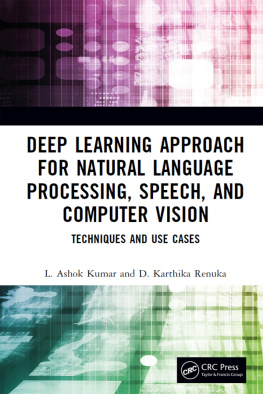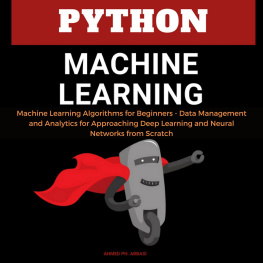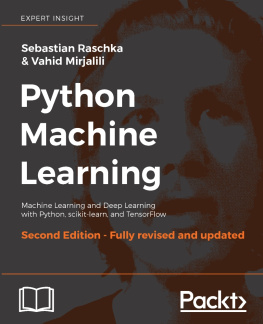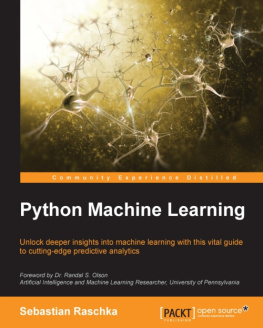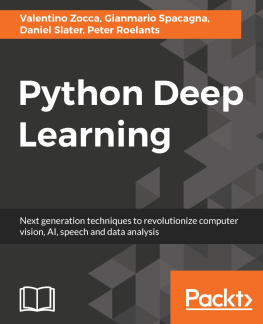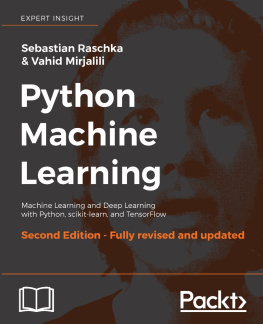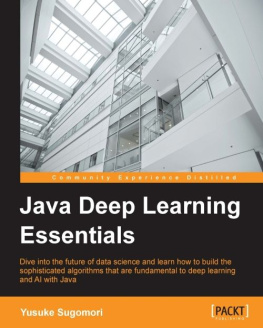Gianmario Spacagna - Python Deep Learning: Next generation techniques to revolutionize computer vision, AI, speech and data analysis
Here you can read online Gianmario Spacagna - Python Deep Learning: Next generation techniques to revolutionize computer vision, AI, speech and data analysis full text of the book (entire story) in english for free. Download pdf and epub, get meaning, cover and reviews about this ebook. year: 2017, publisher: Packt Publishing, genre: Romance novel. Description of the work, (preface) as well as reviews are available. Best literature library LitArk.com created for fans of good reading and offers a wide selection of genres:
Romance novel
Science fiction
Adventure
Detective
Science
History
Home and family
Prose
Art
Politics
Computer
Non-fiction
Religion
Business
Children
Humor
Choose a favorite category and find really read worthwhile books. Enjoy immersion in the world of imagination, feel the emotions of the characters or learn something new for yourself, make an fascinating discovery.

- Book:Python Deep Learning: Next generation techniques to revolutionize computer vision, AI, speech and data analysis
- Author:
- Publisher:Packt Publishing
- Genre:
- Year:2017
- Rating:3 / 5
- Favourites:Add to favourites
- Your mark:
Python Deep Learning: Next generation techniques to revolutionize computer vision, AI, speech and data analysis: summary, description and annotation
We offer to read an annotation, description, summary or preface (depends on what the author of the book "Python Deep Learning: Next generation techniques to revolutionize computer vision, AI, speech and data analysis" wrote himself). If you haven't found the necessary information about the book — write in the comments, we will try to find it.
Take your machine learning skills to the next level by mastering Deep Learning concepts and algorithms using Python.
Key Features- Explore and create intelligent systems using cutting-edge deep learning techniques
- Implement deep learning algorithms and work with revolutionary libraries in Python
- Get real-world examples and easy-to-follow tutorials on Theano, TensorFlow, H2O and more
With an increasing interest in AI around the world, deep learning has attracted a great deal of public attention. Every day, deep learning algorithms are used broadly across different industries.
The book will give you all the practical information available on the subject, including the best practices, using real-world use cases. You will learn to recognize and extract information to increase predictive accuracy and optimize results.
Starting with a quick recap of important machine learning concepts, the book will delve straight into deep learning principles using Sci-kit learn. Moving ahead, you will learn to use the latest open source libraries such as Theano, Keras, Googles TensorFlow, and H20. Use this guide to uncover the difficulties of pattern recognition, scaling data with greater accuracy and discussing deep learning algorithms and techniques.
Whether you want to dive deeper into Deep Learning, or want to investigate how to get more out of this powerful technology, youll find everything inside.
What You Will Learn- Get a practical deep dive into deep learning algorithms
- Explore deep learning further with Theano, Caffe, Keras, and TensorFlow
- Learn about two of the most powerful techniques at the core of many practical deep learning implementations: Auto-Encoders and Restricted Boltzmann Machines
- Dive into Deep Belief Nets and Deep Neural Networks
- Discover more deep learning algorithms with Dropout and Convolutional Neural Networks
- Get to know device strategies so you can use deep learning algorithms and libraries in the real world
This book is for Data Science practitioners as well as aspirants who have a basic foundational understanding of Machine Learning concepts and some programming experience with Python. A mathematical background with a conceptual understanding of calculus and statistics is also desired.
Table of Contents- Machine Learning An Introduction
- Neural Networks
- Deep Learning Fundamentals
- Unsupervised Feature Learning
- Image Recognition
- Recurrent Neural Networks and Language Models
- Deep Learning for Board Games
- Deep Learning for Computer Games
- Anomaly Detection
- Building a Production-Ready Intrusion Detection System
Gianmario Spacagna: author's other books
Who wrote Python Deep Learning: Next generation techniques to revolutionize computer vision, AI, speech and data analysis? Find out the surname, the name of the author of the book and a list of all author's works by series.

